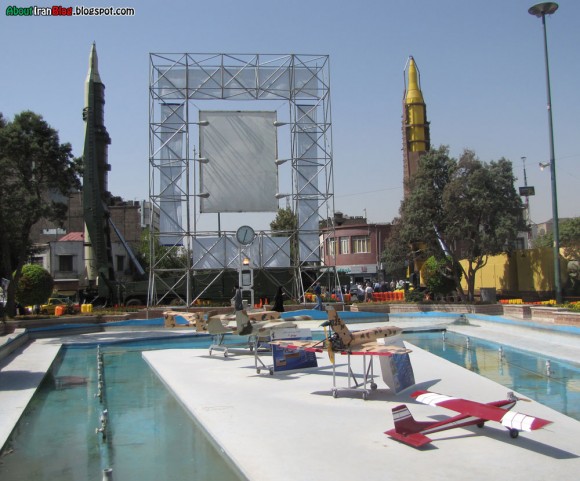Trick or treat!
The About Iran Blog, which is run anonymously, has posted images from a defense exhibition in Tehran. The images show placards with technical data for the Shahab, Ghadr, Qiam and Seijil missiles.
This is definitely a treat.
The placards contain data relating to range, payload, dimensions and mass. Someone probably needs to play with the data in a model, but it is worth pointing out that the data is essentially consistent with the public descriptions of the missiles in question. Here is a simple range-comparison chart:
| Missile | Placard (km) | US IC (km) |
| Shahab-2 | 500 | 500 |
| Shahab-3/Ghadr-F | 1948 | 1900 |
| Sejil | 2000 | 2000 |
| Qiam-1 | 800 | n/a |
The US estimates are drawn from Unclassified Report on the Military Power of Iran (April 2010) and Ballistic and Cruise Missile Threat (August 2009).
The authors of the About Iran Blog have translated the technical data, which is available on their site.
The comparisons, of course, are imprecise: US intelligence estimates are presented in miles (so they are rounded) and the assigned payload, not known in the US estimate, makes quite a difference. Still, looks like we are in the right neighborhood.
It is, of course, possible that these are Western data reproduced although the Iranians seem quite proud of their accomplishments. I seized on the bizarrely precise estimate for the Ghadr-F, but nothing suspicious popped up. Perhaps more digging is in order.
The placards are also consistent with the hypothesis, advanced by Mike Elleman and Robert Schmucker and Markus Schiller that the Qiam-1 is essentially a Shahab-2 with a different nose cone.
There is also some jet-vane porn, which is a favorite subject of this blog and, it turns out, the United States Government. (WARNING: LEAKED CABLE WITH SECURITY MARKINGS.)


their air force looks pretty formidable too…
Isn’t it curious that the jet vanes’ “Do Not Touch” labels are stenciled in English?
I thought that was hilarious, given the problems they’ve had with jet vanes.
Must be for the export market.
English writing is common and appears on all Iran’s missiles and aircraft.
It’s common for English to be used for aerospace applications. Standardization.
Scrutinize refurbished IRIAF Tomcats, Tiger IIs and Phantoms, and you see the same 70s era U.S. military aircraft stencils, all reapplied as original.
The missile exhibition is held every year at Baharestan Square, Tehran (near Majlis building) in the anniversary of the beginning of Iran-Iraq war (which began at Sep. 22, 1980). It’s an essential go-to for Iranian military enthusiasts. Perhaps Arms Control Wonk could send a correspondent there for the next year!
You can find many other pictures of the exhibition around the Persian-language web.
I guess your policy is not to paste the wikileaks — anyway google a wikileak called:
ID
10STATE17263
SUBJECT
U.S.-RUSSIA JOINT THREAT ASSESSMENT TALKS
where you will find range info that is different for S-2, S-2 and S-3 than that quoted above (but this may be due to better payload assumptions) — and an excellent Russian analysis which shows how the US is hyping the Iran and NK “threat”.
BTW, Iran will draft a resolution on missiles for UN GA’s first committee:
http://www.presstv.ir/detail/207761.html
Anyone have any specs/photos of the Jericho-III?
http://www.nytimes.com/2011/11/03/world/middleeast/israel-tests-a-long-range-missile.html
Robert and I have looked into the Qiam again. By now, we are pretty sure that it is based on the Shahab 2/Scud C, with slightly elongated tanks and a guidance compartment that reminds us of Iraqi Scud modifications. Our reconstructed Qiam is very close to the stated Iranian mass figure. Range should be more than 700 km, but the given max altitude (“flight ceiling”) does not fit into the dataset – 126 km are definitely too low. It seems that, as in many cases before, some stated numbers are close to reality, while others are far off the mark – eventually, this game is like poker, and nothing is more rewarding (and more fun) than confusing your adversaries.
Markus,
thank you. If you google the wikileak I quote above you will see slightly divergent figures obtained? What payload mass do you assume?
Do you think the Russian assessment or the US one in that cable is more accurate?
Anon,
With the “slightly divergent figures”, I suppose that you are referring to the other missiles, since I do not see Qiam mentioned in the text. Payload mass assumptions are not too important, since without any evidence they are what they are: Assumptions. No point in arguing over different assumptions without knowing the real figure (at least as long as the assumptions are reasonable).
Of course one side seems closer to my assessments than the other, but again, there is no point in claiming that one side is more accurate than the other without knowing the real situation. Only once there is evidence for the real situation available one can state that one side was more accurate than the other.
Well, my point perhaps subtle was that the wikileak values are systematically lower for ranges than any other values. I wonder why that is?